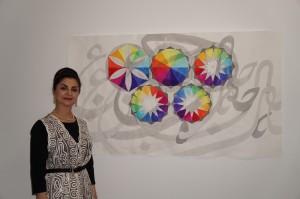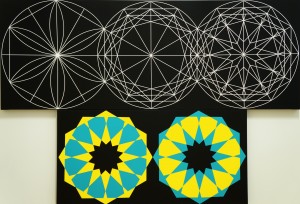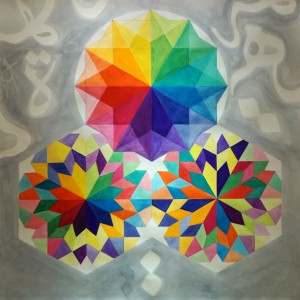Painter Fariba Abedin Bridges Art and Science at the Jung Center
 When she first moved to Houston with her husband in 1983, Fariba Abedin was already an accomplished artist, with a BFA from the Massachusetts College of Art. Never one to stop learning, she spent the next three decades taking just about every art class in the city. She studied watercolors at the Watercolor Art Society–Houston, ceramics and sculpture at Art League Houston, and abstract painting at the MFAH’s Glassell School. Even on vacation she remained the perpetual student, taking advantage of her annual visits to her native Tehran to take instruction in Persian calligraphy.
When she first moved to Houston with her husband in 1983, Fariba Abedin was already an accomplished artist, with a BFA from the Massachusetts College of Art. Never one to stop learning, she spent the next three decades taking just about every art class in the city. She studied watercolors at the Watercolor Art Society–Houston, ceramics and sculpture at Art League Houston, and abstract painting at the MFAH’s Glassell School. Even on vacation she remained the perpetual student, taking advantage of her annual visits to her native Tehran to take instruction in Persian calligraphy.
“I’m forever a student,” Abedin said while giving a tour of her new exhibition, “This Time on Paper,” which runs through February 28 at the Jung Center. “I began doing photorealistic painting, then I did representational painting, abstract painting, drip painting, expressionism, gestural painting. Eventually, I went back to my roots.”
 For the past few years, Abedin has been making colorful, mandala-like paintings influenced by both Persian culture and 20th century abstract art. She was drawn to the rigorous geometry of mandalas from her background in architecture, which she studied in college, as well as traditional spiritual beliefs about the connection between nature and mathematics. “Mandalas started thousands of years ago, with Buddhism,” she explained. “Judaism and Christianity and Islam all have their own geometric forms and shapes, often using squares and circles.”
For the past few years, Abedin has been making colorful, mandala-like paintings influenced by both Persian culture and 20th century abstract art. She was drawn to the rigorous geometry of mandalas from her background in architecture, which she studied in college, as well as traditional spiritual beliefs about the connection between nature and mathematics. “Mandalas started thousands of years ago, with Buddhism,” she explained. “Judaism and Christianity and Islam all have their own geometric forms and shapes, often using squares and circles.”
Each of the paintings in the Jung Center show took between two and four weeks to produce, Abedin said. She begins by cutting and pasting colored pieces of paper onto a piece of backing, then scans the image into Adobe Photoshop, where she manipulates the colors to achieve the desired effect. Then, using the Photoshopped image as a guide, she paints the image directly onto paper without the use of rulers. She describes her process as an almost meditative practice.
“The paintings are all freehand, and if I mess up even a small section I can’t take it back,” she said. “If any of the lines aren’t perfect or if a drop of paint falls on the paper, I can’t take it back. So I almost have to hold my breath when I’m working. Then, when I’m using oil paint, I have to wait 24 hours for one layer to dry before I paint the next layer.”
 Several of the paintings incorporate Persian calligraphy, often using poetry by the 13th-century Islamic poet Rumi. It’s this blending of the literary and the visual, the spiritual and the mathematical, that makes Abedin’s paintings so fascinating. “My art is actually a marriage between fine art and science,” she said. “Whether it’s color studies, whether it’s geometrical studies, it’s working with science.”
Several of the paintings incorporate Persian calligraphy, often using poetry by the 13th-century Islamic poet Rumi. It’s this blending of the literary and the visual, the spiritual and the mathematical, that makes Abedin’s paintings so fascinating. “My art is actually a marriage between fine art and science,” she said. “Whether it’s color studies, whether it’s geometrical studies, it’s working with science.”
Although Abedin respects artists who create more politically engaged work, she wants her own paintings to be an oasis from political strife: “There is a lot of suffering in life, generally, throughout the whole world. I want my viewers, when they stand in front of my work, not to worry about the rest of the world, and just enjoy my work for the moment that they’re standing there. This is my goal, to make people happy.”
“This Time on Paper.” Free. Jung Center, 5200 Montrose Blvd. 713-524-8253. junghouston.org
